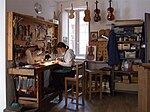List of Intangible Cultural Heritage elements in Italy

The United Nations Educational, Scientific and Cultural Organisation (UNESCO) intangible cultural heritage elements are the non-physical traditions and practices performed by a people. As part of a country's cultural heritage, they include celebrations, festivals, performances, oral traditions, music, and the making of handicrafts.[1] The "intangible cultural heritage" is defined by the Convention for the Safeguarding of Intangible Cultural Heritage, drafted in 2003[2] and took effect in 2006.[3] Inscription of new heritage elements on the UNESCO Intangible Cultural Heritage Lists is determined by the Intergovernmental Committee for the Safeguarding of Intangible Cultural Heritage, an organisation established by the convention.[4]
Italy ratified the convention 30 October 2007.
Intangible Cultural Heritage elements[edit]
Representative List[edit]
| Name | Image | Year | No. | Description |
|---|---|---|---|---|
| Opera dei Pupi, Sicilian puppet theatre | 
|
2008 | 00011 | The Opera dei Pupi is a marionette theatrical representation of romantic poems traditionally performed in Sicily. |
| Canto a tenore, Sardinian pastoral songs | 
|
2008 | 00165 | The cantu a tenòre is a style of polyphonic folk singing characteristic of Sardinia. |
| Traditional violin craftsmanship in Cremona | 
|
2012 | 00719 | The Cremona's traditional violin making is an ancient form of handicraft typical of Cremona, where bowed string instruments like violins, violas, cellos and double basses have been made since the 16th century. |
| Celebrations of big shoulder-borne processional structures | 
|
2013 | 00721 | These celebrations are a particular form of Catholic procession which involves the use of large votive structures to be carried on the shoulders, particularly in Nola (Festa dei Gigli), Palmi (Varia di Palmi), Sassari (Discesa dei Candelieri), and Viterbo (Macchina di Santa Rosa). |
| Mediterranean diet +[a] | 
|
2013 | 00884 | The Mediterranean diet is the traditional food and methods of preparation used by the people of the Mediterranean basin, as well as everything related to them. |
| Traditional agricultural practice of cultivating the 'vite ad alberello' (head-trained bush vines) of the community of Pantelleria | 
|
2014 | 00720 | Vines traditional agricultural practice in Pantelleria. |
| Art of Neapolitan 'Pizzaiuolo' | 
|
2017 | 00722 | The culinary practices of the Pizzaiuolo –the pizza baker–, in Naples. |
| Art of dry stone walling, knowledge and techniques +[b] | 
|
2018 | 01393 | Dry stone is a building method by which structures are constructed from stones without any mortar to bind them together. |
| Celestinian forgiveness celebration | 2019 | 01276 | The Celestinian forgiveness is a religious and historical annual event held in L'Aquila. | |
| Alpinism +[c] | 
|
2019 | 01471 | Alpinism is a set of outdoor activities that involves ascending mountains. |
| Musical art of horn players, an instrumental technique linked to singing, breath control, vibrato, resonance of place and conviviality +[d] | 2020 | 01581 | ||
| The art of glass beads +[e] | 
|
2020 | 01591 | The craft of glass beading dates back to ancient Egyptian and Roman civilizations and it is practiced particularly in Murano. |
| Falconry, a living human heritage +[f] | 
|
2021 | 01708 | The origin of falconry goes back to the use of hunting by birds of prey as a mean of hunting but it has evolved over time to become part of the cultural heritage of the people. |
| Truffle hunting and extraction in Italy, traditional knowledge and practice | 
|
2021 | 01395 | |
| Lipizzan horse breeding traditions +[g] | 
|
2022 | 01687 | |
| Transhumance, the seasonal droving of livestock +[h] | 
|
2023 | 01964 | Transhumance is a type of pastoralism or nomadism, a seasonal movement of livestock between fixed summer and winter pastures. |
| Traditional irrigation: knowledge, technique, and organization +[i] | 2023 | 01979 | ||
| The practice of opera singing in Italy | 2023 | 01980 |
Good Safeguarding Practices[edit]
| Name | Year | No. | Description |
|---|---|---|---|
| Tocatì, a shared programme for the safeguarding of traditional games and sports +[j] | 2022 | 01709 |
See also[edit]
Notes[edit]
- ^ Shared with Croatia, Cyprus, Greece, Morocco, Portugal, and Spain.
- ^ Shared with Croatia, Cyprus, France, Greece, Slovenia, Spain, and Switzerland.
- ^ Shared with France and Switzerland.
- ^ Shared with Belgium, France, and Luxembourg.
- ^ Shared with France.
- ^ Shared with Austria, Belgium, Croatia, Czechia, France, Germany, Hungary, Ireland, Kazakhstan, Republic of Korea, Kyrgyzstan, Mongolia, Morocco, Netherlands, Pakistan, Poland, Portugal, Qatar, Saudi Arabia, Slovakia, Spain, Syria, and the United Arab Emirates.
- ^ Shared with Austria, Bosnia and Herzegovina, Croatia, Hungary, Romania, Slovakia and Slovenia.
- ^ Shared with Albania, Andorra, Austria, Croatia, France, Greece, Luxembourg, Romania, and Spain.
- ^ Shared with Austria, Belgium, Germany, Luxembourg, Netherlands, and Switzerland.
- ^ Shared with Belgium, Croatia, Cyprus, and France.
References[edit]
- ^ "What is Intangible Cultural Heritage?". UNESCO Intangible Cultural Heritage. Retrieved 13 January 2024.
- ^ "Text of the Convention for the Safeguarding of Intangible Cultural Heritage". UNESCO Intangible Cultural Heritage. Retrieved 13 January 2024.
- ^ "The States Parties to the Convention for the Safeguarding of the Intangible Cultural Heritage (2003)". UNESCO Intangible Cultural Heritage. Retrieved 13 January 2024.
- ^ "Functions of the Intergovernmental Committee for the Safeguarding of Intangible Cultural Heritage". UNESCO Intangible Cultural Heritage. Retrieved 13 January 2024.
External links[edit]
- UNESCO Intangible Cultural Heritage: Official site
- UNESCO Intangible Cultural Heritage in Italy: Official site


